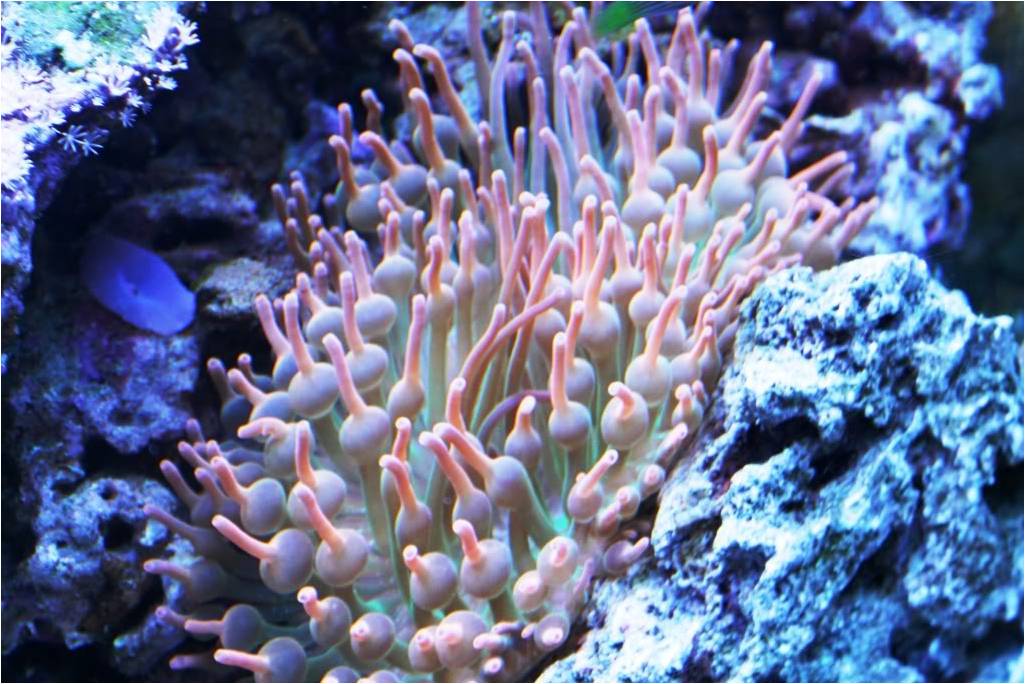
Keeping Anemones
Just as with all marine critters, you need to make sure you know what you’re getting yourself into before getting an anemone.The below is based on my first hand experiences and what I learned from researching before getting my anemones.
Water Quality
Generally speaking, they need the same type of water conditions as SPS corals require. Anemones need: high levels of dissolved O2, a salinity at 1.024 to 1.026, a stable pH between 8.1 and 8.3, temp between 76 and 78 F, calcium between 400 and 450, dKH at 8.0 to 12.0, magnesium between 1,250 and 1,350 ppm, nitrate at 2 ppm or less (closer to 0 ppm is best), stable phosphate at 0.002 ppm or less (0 is best), and finally 0 ppm of ammonia and nitrite. Just as with most all aquatic life, stable parameters and parameters at or near the desired levels is the key to a healthy and happy tank with healthy and happy anemones.
One important thing to keep in mind is that it is best to maintain proper and balanced levels of Calcium, Alkalinity, and Magnesium in order to have a proper and stable pH. This will help to maintain levels close to that of natural sea water. Your nitrates should be less than 2ppm (closer to 0 is best), and phosphates less than 0.002 ppm.
Aquarium Conditions/Factors
A) The Maturity of the Aquarium: This aspect of keeping anemones is even more important to people who are newer to the hobby as compared to seasoned veterans (and just to be clear, I’m not claiming to be a seasoned veteran here either). The reason being is that tanks that have been set up and running for less than 6 months can be prone to swings in water parameters. Most anemones cannot handle swings in water parameters very well at all.
B) Water Flow & Movement: Anemones need at least some water flow around them. They breathe by absorbing oxygen directly from the water. In the wild, anemones also need water flow to bring food to them and for carrying away wastes. Generally speaking, anemones will need moderate to low water flow. One of the most common causes for an anemone not to be happy in your tank is that they do not like the water flow around them. This will sometimes cause them to move until they find a spot in the tank that they like. Some type sof anemones are more tolerant of flows and water movement as compared to others
C) Lighting Requirements: Anemones need really good lighting to survive, similar levels to SPS corals. They will get a lot of their required nutrients through photosynthetic processes. They contain zooxanthellae algae within their tissues that will allow them to use light for nutrients. Metal halides or T5 HO fixtures traditionally have been the best choices for light fixtures. High quality LED will also provide all the lighting a anemone would need. I have had great success using T5HOs as well as good quality LEDs with my bubble tip and carpet anemones. I am currently using LEDs. Typically, if your lighting is just a little less than ideal for your anemone, you can compensate for that with some regular feedings.
There is a lot of differing opinions over what a minimum light requirement should be. I have found as a general rule of thumb, 4 watts per gallon of 14,000K or higher lighting should be a good starting point for tanks that are about 20 inches tall. Once again, that is only based on the success that I have had with my anemones.
D) Oxygen levels: Anemones do best when there is a good level of oxygen in the water. This is not very different from other requirements of marine life. This can be easily achieved by having good water movement at the surface of the water in the tank, and using a protein skimmer.
Feeding Anemones
There are a few schools of thought on this as well. Some people do not feed their anemone anything and they remain healthy and grow in their tank for many years provided the lighting remains at the proper level for their anemone. In my experience, I have kept my anemones healthy and growing by feeding them about 2 or 3 times per month. You can even feed them up to 3 times a week if you want to accelerate their growth. I feed mine about weekly and they grow and spawn and seem to be thriving.
As for foods, stick to meaty foods that are high in proteins. Claims, Scallops, Shrimp, Mussels, and Krull are all good choices to offer. Stay away from silversides as much as possible. Typically you are risking potential quality issues with silversides as compared to the other above listed choices. There are other options for food, but I have not tried any of them. The below link can provide you with a few suggestions for feed anemones.
https://reefaquarium.com/2012/feeding-high-quality-froozen-foods/
When you feed your anemone, make sure the food is small enough to easily fit in the anemones mouth. Place the food near the anemones mouth (as near as you can). I use a long pair of tweezers for this. Once the food touches the anemone, it should start to react right away. Anemones can take up to 2 to 3 minutes to take the food and put it in its mouth followed by closing it’s mouth. A stressed anemone will take longer. Just keep an eye on the other critters and fish in the tank as they usually will try to steel food form the anemone while it is trying to eat it.
Clownfish
Do anemones need clown fish ?………. No they do not. Anemones are perfectly fine without them. There are certain benefits to having clown fish hosting in your anemone though. Benefits like: the clownfish will defend the anemone from all other fish and some critters in the tank, the clown fish will place uneaten food on the anemone (basically feeding it) and the clown fish will gain protection from other fish by hosting in the anemone. However, both the clown fish and anemone can be perfectly healthy and happy without each other.
If you are going to get a pair of clown fish to host in your anemone, make sure you get the correct type of clown fish that will naturally host in your anemone. As a general rule of thumb, not all clown fish will host in all types of anemones.
On the other hand, an anemone can represent a risk to other tank inhabitants. They are very opportunistic feeders. Some types of anemones will grab and eat almost any smaller slow moving fish or invert that may come in contact with their tentacles. My carpet anemone for example has eaten many snails (and spit out the shells), a orange-back wrasse, and all of my cleaner shrimp while my bubble tip anemones would not eat any of them
.
Wandering Anemones
Anemones move because they are not happy with the spot they are currently sitting in or the water quality might have changed. This can also be an indication that something is wrong in the tank or the result of something that you might have changed. If your anemone starts moving and you have not changed the lighting or water flow, there could be a problem with your parameters. Some anemones are also more likely to move than others. I’ve had bubble tip anemones that would split and then one of the new anemones would move around until it found a spot it liked away from the other new anemone. I also have carpet anemones that have not moved at all in years.
Adding a Anemone to Your Tank
If you find that you want to add an anemone to your tank after researching the requirements, I would suggest following the below steps to add the anemone to your set-up.
A) Turn off your powerheads for the first 24 hour (or so) the anemone is in the tank. This will help the anemone to settle into their new home
B) The first step would be to ensure your tank has matured and your water parameters are in line and stable as stated above.
C) Next you have to plan for a suitable spot in your tank. Some anemones prefer to attach their boots to rocks, other like to attach to the bottom glass of the tank. Some anemones also need 3 to 6 inches of substrate to dig their boot in. Research these requirements first and plan a spot in your tank for your anemone. These requirements also include lighting and water flow.
D) Now you should be ready to purchase your anemone. Pick one out at the store that looks healthy. They should have at least close to normal coloring and their mouth should be closed.
E) Next you will need to carefully take you anemone home and acclimate him to your water conditions. A dip acclimation method works best for anemones.
F) In addition to acclimating your anemone to the water parameters, you will also want to acclimate your anemone to the light in the tank. One of the best methods for that is to using some type of plastic screening that will allow light to pass through. Add three layers on top of the tank and remove one screen every 3 days or so. This will allow the anemone to slowly adjust to the light in your tank.
F) During the first few days to a week, your anemone may become very stressed while he gets used to his new home. The anemone may even hide in the rocks for a day or two or have it’s mouth wide open. This type of reaction can be expected some times.
G) Until the anemone settles into the tank, it would be a good idea to turn off the powerheads at night. In my experience, if your anemone is going to move, it will happen after you turn the tank lights off. You don’t want to loose your anemone to a powerhead if you can avoid it.
.
If your anemone is showing one or more signs of stress listed below longer than a week after being added to your tank, or at any time after that, you could have a problem in your set-up
A)The anemone is expelling a long and stringy brown liquid. This could be a sign the water conditions are not good and you anemone is expelling some of its zooxanthellae. This can be a serious condition. Just be sure the anemone is not expelling food wastes (keep in mind there is only one opening to the digestive system).
B) The anemone seams to shrink and expand a lot. Anemones will deflate and then re-inflate as a way of changing the water inside of them flushing out wastes. If this is continually happening (say daily or more), or if it remains shrunk for longer periods of time, your anemone might be having problems or is stressed.
C) The mouth is open when it is not eating or expelling wastes.
D) When an anemone moves into the rocks and hides from sight (with the exception of rock anemones).
F) Your anemone looks pale or almost colorless, otherwise known as “bleaching”. Basically this is another symptom / result of the anemone expelling zooxanthellae or was not properly acclimated to your tank lighting.
G) The mouth remains open or perhaps even extended although the anemone is not eating. In extreme cases of stress, the mouth will appear inverted.
H) The anemone will not attach its self anywhere in the tank.
Bleached Anemone
If you anemone has become bleached (least most of it’s color) once he has been in your tank for a while and is / was happy, this is most likely a indication that something is wrong with either the lighting or water quality. Below are the most common response for a anemone to become bleached.
A) Too much light
B) Not enough light
C) Nutrient level in the water is too high
D) Nutrient level in the tank is too low.
The below is based on my experiences with carpet and bubble tip anemones. There are many other types of anemones in the hobby today, however, I have not kept any of them.
Bubble Tip Anemones (BTA)
Bubble tip anemones are among the more common anemones available in the hobby these days. In my experience, they are among the easier anemones to keep and likely the hardiest of the anemones. BTAs typically like to attach to the rocks in a spot where they can attach their boot into a crevasse in the rock and protect their boot. They like moderate flow and high lighting conditions
The most common is the red or green bubble tip, however you can get color variations from blue to orange as well. They can be easily identified by the longer tentacles (1 to 2 inches in length) with a “bubble” structure near the end of the tentacle. The size and shape of the bubble structure on the end of the tentacle will vary between different BTAs from very large to almost nonexistent. These anemones can get to be a little over one foot across which is why I would suggest a tank size of no less than 30 gallons for these anemones.
BTAs typically like to attach to the rocks in a spot where they can attach their boot into a crevasse in the rock and protect their boot. They like moderate flow and high lighting conditions. BTAs are also the most likely anemone to move around in your aquarium. Any change, even one so small that you may not even be able to test for, can lead to these guys moving sometimes.
It is also very common for BTA to reproduce in the home aquarium when kept in ideal conditions. They can produce sexually by spawning, or asexually by splitting. I had started off with one BTA in one of my tanks which ended up as 5 BTAs one year later. It seemed like once the anemone would get to close it’s maximum size, it would split and one half would move around the tank until it found a spot it liked.
If you would like clown fish, consider the below list of some the clown fish that have been known to readily host in these anemones. I found this list in reef keeping magazine
Amphiprion Clarkii
Amphiprion Ocellaris, ocellaris clown fish (all color variations
Amphiprion Akindynos, or barrier reef clown
Amphiprion Bicinctus, or two-band clown
Amphiprion Chrysopterus Blueline or Orange fin clown
Amphiprion Ephippium or fire clown
Amphiprion Frenatus, or tomato clown
Amphiprion latezonatus, or wide-band clown
Amphiprion. Mccullochi, or Mcculloch’s clown
Amphiprion. Melanopus, or cinnamon clown
Amphiprion rubrocinctus, or Australian clown
Amphiprion tricinctus, or three-band clown
The below is a pic of my rose bubble tip anemone about 3 weeks after it split. Around 1 or 2 weeks after this picture was taken, the anemone on the left moved to another spot in the tank.
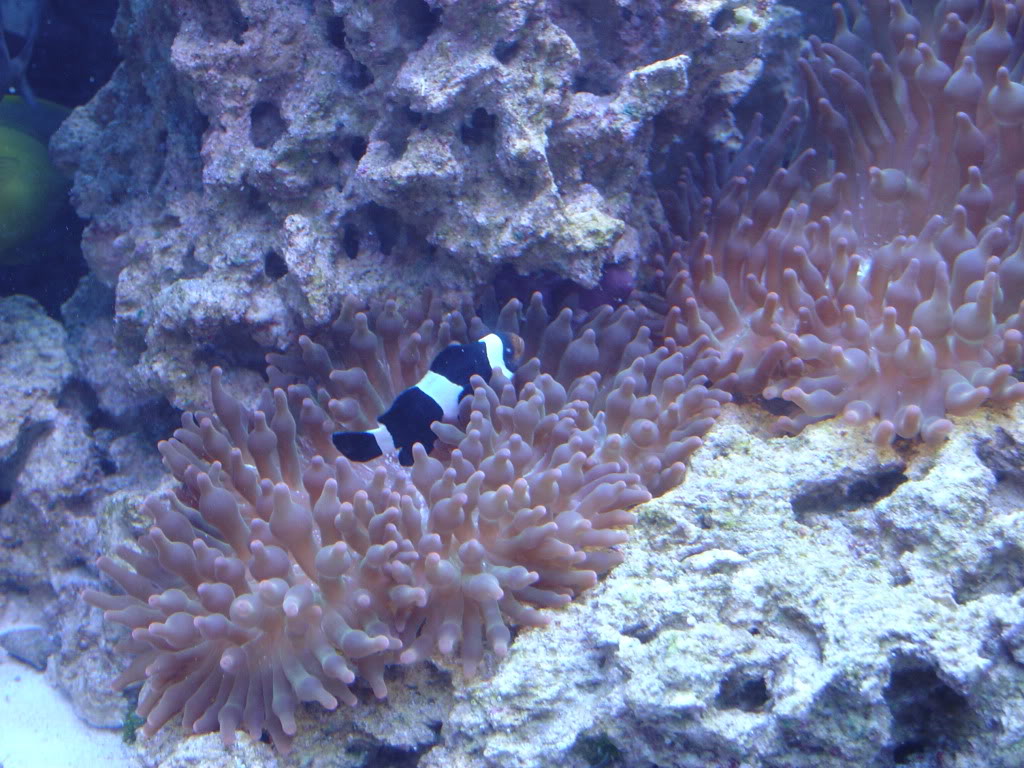
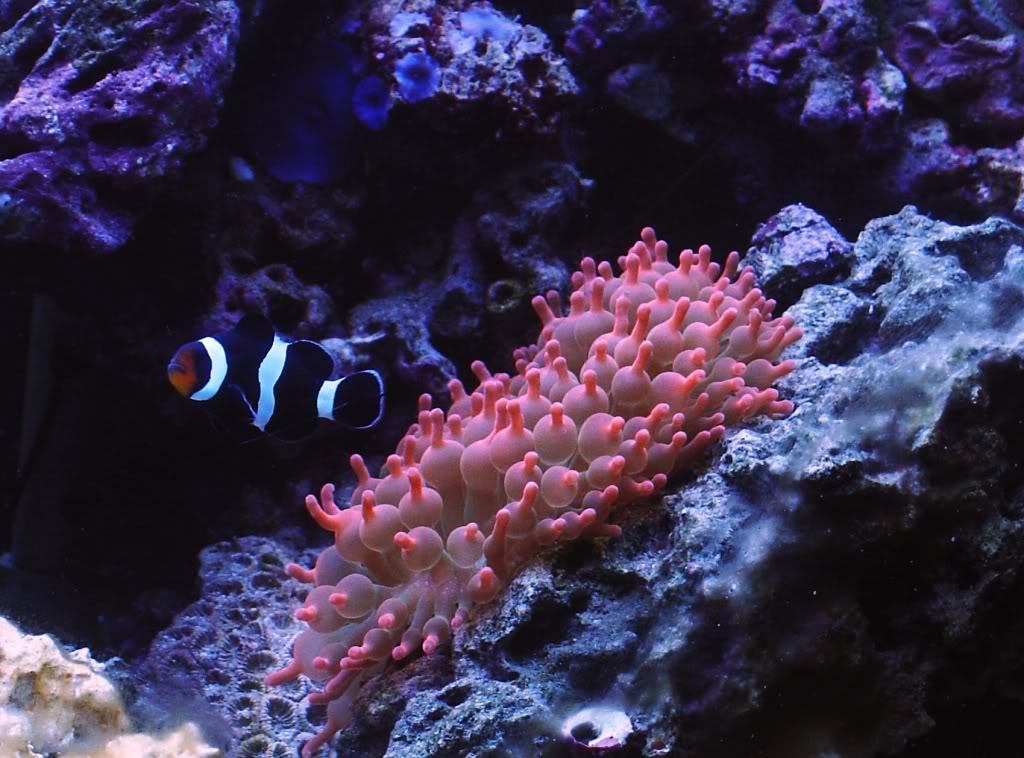
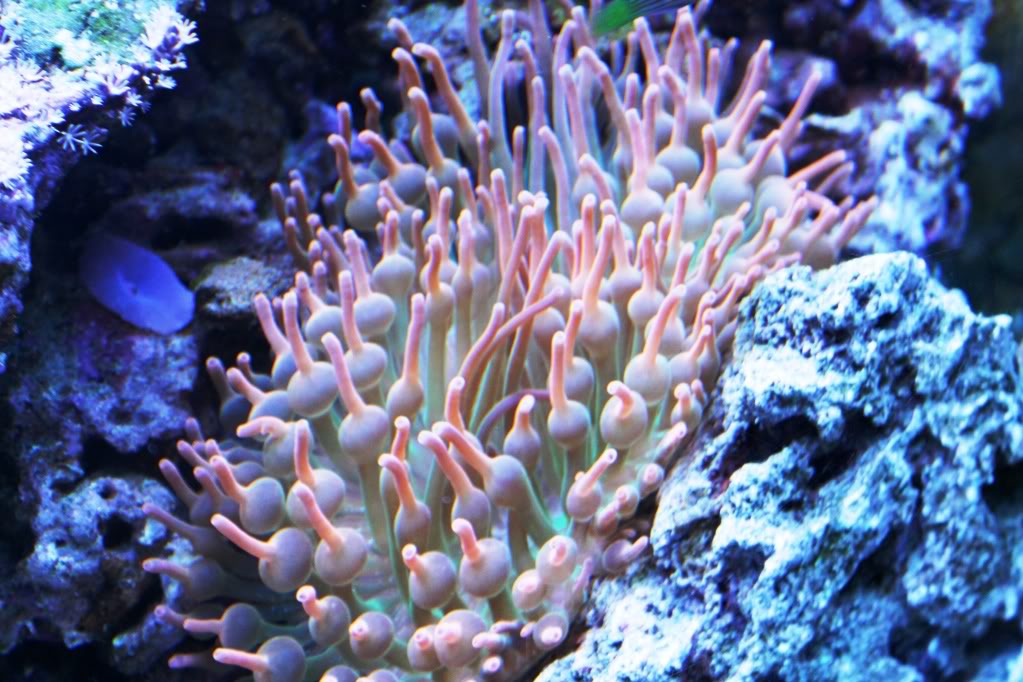
Carpet Anemones
These are among the more difficult anemones to care for out of all the different types of anemones. The two most common carpet anemones are the Gigantea and the Haddoni. Both are similar and can often be misidentified. It would be important to know the difference in the appearance of the two as they have some very minor differences in their requirements that might make a difference in the long term.
Gigantea Carpet Anmones
These are amount these most difficult anemones to care for. While I have only kept on of these anemones for a short time now, I had spent a lot of time learning about this anemone so I would be able to accurately tell the difference between gigantean and haddoni anemones. The gigantean carpet anemone (Stichodactyla Gigantea) will get over 1.5 feet in diameter, and will frequently get to around 2 feet when kept in ideal conditions. In the wild they can get to well over 3 feet. Their tentacles are the longest of the carpet anemones but much shorter than a long tentacle or BTA. The tentacles will be around ¼ to ¾ inches in length. I like to think of it as looking like 1960’s shag carpeting. Typically they will be a brown or sandy color but other less common colors like green, blue, yellow, purple, and pink can also be found. Even harder to find colors include red and a dark blue. They are not known to reproduce in the home aquarium.
A lot of people recommend that you will need at least a 40 gallon breeder tank for one of these guys (species only tank), but I would highly recommend nothing less than a 75 gallon would be best. They will also do best with moderate to slighting stronger flow. I have seen these guys plant themselves almost directly into the flow of a return pump line. They also require slightly more lighting levels as compared to other anemones (they are the highest demanding for light). Gigantea anemones like to plant there boot in 3 to 6 inches of substrate attaching it to the bottom of the tank. This way, if they feel threatened they can fully retract themselves into their boot under the substrate completely submerging themselves under the substrate.
The below pic are of some rare colors in Gigantea anemones that were just received at a local fish store where I live.
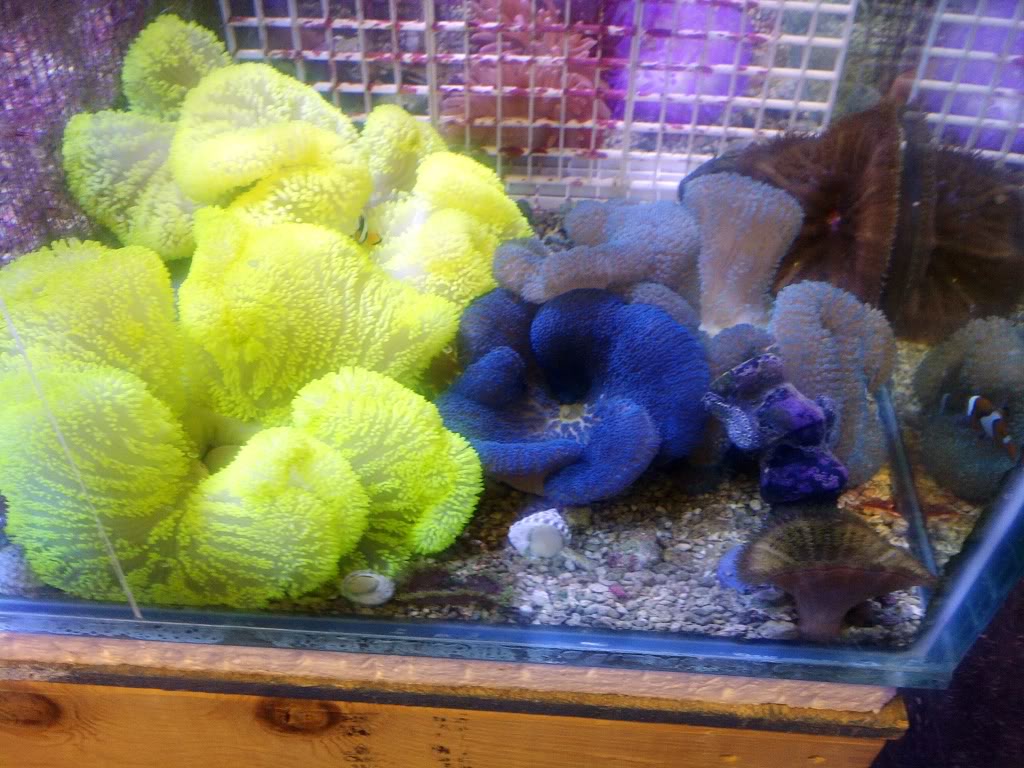
The below is a picture of my blue carpet anemone.
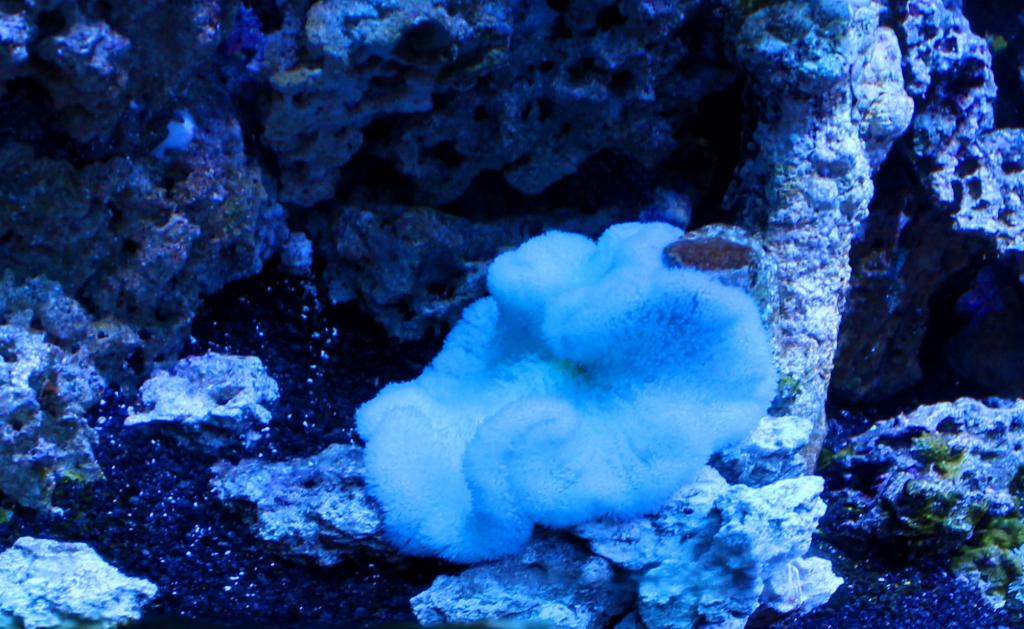
Handdoni Carpet Anemones
The Haddoni anemone (Srichodactyla Haddoni) can get as large as Gigantea growing to around 2’ in diameter. Although difficult to keep, they are not as difficult as the gigantean anemone. They have very short tentacles that look more like colored bumps rather than tentacles. I like to think of it as looking like commercial grade carpeting. Their tentacles are around ½ the length of the tentacles of a Gigantea anemone. Typically they will be a brown or sandy color but other less common colors like: green, blue, and purple. More rare colors are red and pink.
Haddonis have been known to grow very fast. My haddion grew from 4 inches to well over 12 inches in 18 months. Most people feel they will need nothing less than a 40 gallon breeder tank for a species only set-up, but I would recommend they should be kept in nothing smaller then a 75 gallon tank. They typically like to plant themselves in the sand. They also like to plant their boot in 3 to 6 inches of substrate attaching it to the bottom of the tank. This way, if the feel threatened they can fully retract themselves into their boot under the substrate completely submerging themselves under the substrate. While they have the same lighting requirements of Gigantea anemones, haddonis like low to moderate flow (less flow than giganteas).
Haddonis are one of the more aggressive feeders quickly snatching up anything the comes in contact with it’s tentacles. Their tentacles should be extremely sticking making it very hard to handle these guys. My haddoni has eaten many snails (spitting out the shells), shrimp, and a few fish.
Clown fish are the most likely to host in a carpet anemone as compared to all other anemones. If you would like clown fish, consider the below that have been known to readily host in these anemones.
Amphiprion ocellaris, or ocellaris clown fish (all color variations)
Amphiprion akindynos, or barrier reef clown
Amphiprion chrysogaster, or Muritisn clown
Amphiprion chrysopterus, or orange fin clown
Amphiprion clarkia, or clarkie clown fish
Amphiprion. Polymnus, saddleback clown
Amphiprion sebae, or just sabae clown
Amphiprion Chrysopterus Blueline or Orange fin clown
Amphiprion Ephippium or fire clown
Amphiprion Frenatus, or tomato clown
The below is a pic my red haddoni carpet anemone just after I had put him in my tank. He was around 4 inches in size then. The next few photos show him closer to his current size of around 14 inches.
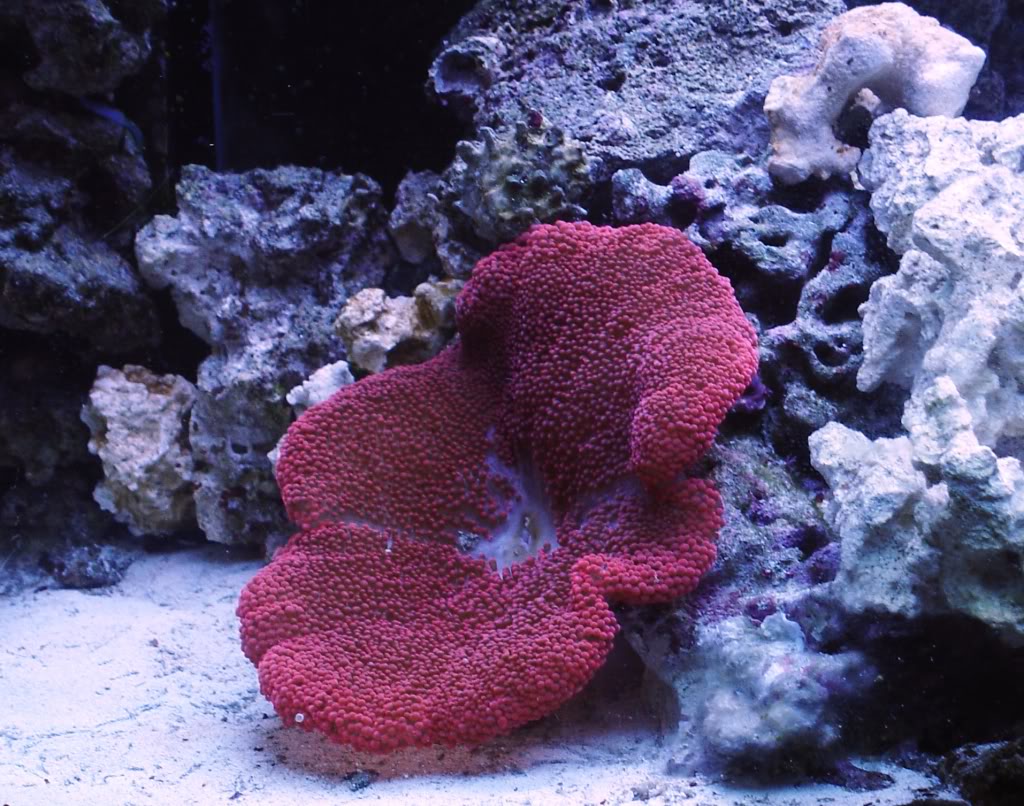
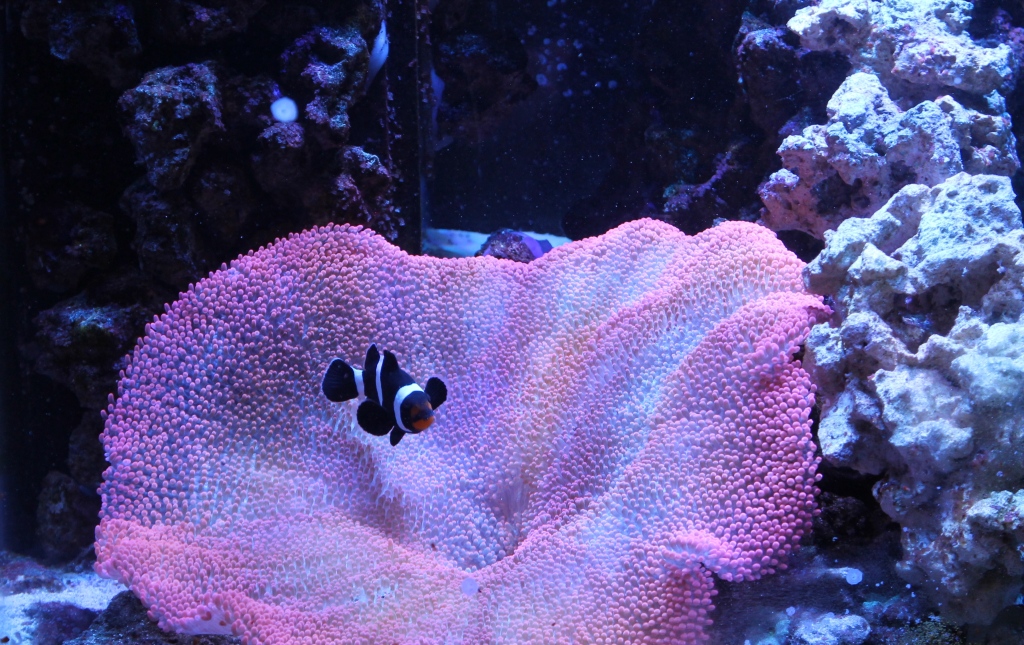
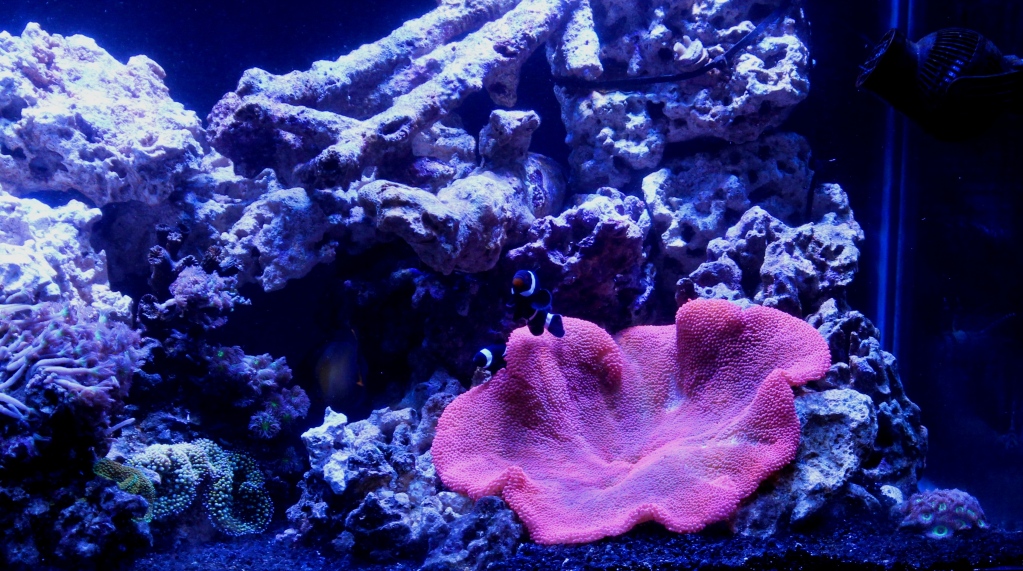
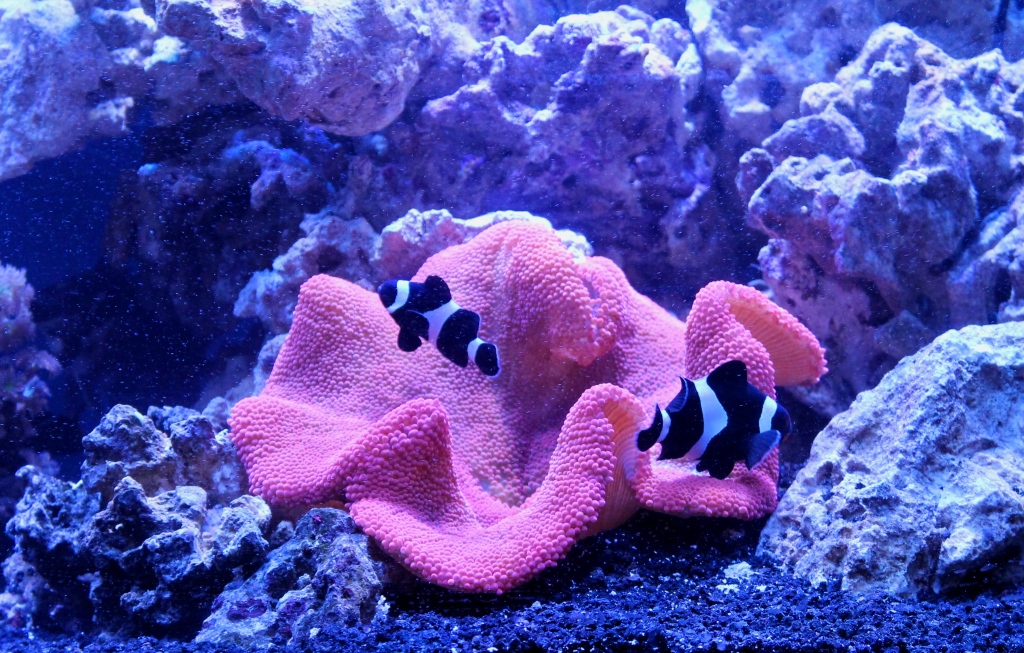
And just one last note on anemone reproduction. You can search the internet and find a lot of information / instructions / examples of how to frag anemones. IMO, this is a safe practice to consider. In the wild there are only two different species of anemones that are known to commonly reproduce by splitting, all other anemones reproduce sexually.
There are some fragging examples that I found which shows recently fragged anemones a few days after being cut up. Even in some of these examples, they state a pretty high mortality rate (50 to 75%) and none of them offer evidence of how the anemones that survive the procedure are doing 3 months, 6 months, or a year afterwards. I have not been able to find creditable information to support the practice of frag anything with a mouth and a stomach and expect it to survive or remain healthy through the long term.
Below are a few links to published articles that speak to anemone reproduction. Please read them before you frag a anemone (I forgot where I found those links).
http://www.wifeofnerd.com/images/Bro…%20crisp .pdf
http://www.wifeofnerd.com/images/Emb…%20cr isp.pdf
References and other good info:
http://www.karensroseanemones.net/
http://www.scribd.com/doc/50307006/AnemoneFAQ
http://reefkeeping.com/issues/2006-03/nftt/index.php
If you have any questions about this article, please feel free to start a thread in our forum using the below link. If you are not already a member, please take the time to sign up and join.
http://www.aquaticcommunity.com/aquariumforum/newthread.php?do=newthread&f=62
My purple carpet decided to move from his that he liked . Then up the back glass n face first into my powerhead cage. I took the cage off but some of him had gotten into the cage n sorta of meshed inbetween. Cant pull him out or off. Will he eventually puul off of it?
I would suggest just turning off that power head for now. Let him move off on his own.
Have you identified why the anemone moved in the first place? Did you just add the anemone to your tank? Have you checked your water parameters lately ?
Cliff can you still be contacted here
Yes, do you have a question ?
May I know spectrum ranges you used for your anemone within LED lighting ?
They are AI SOLs. I have been using them with my carpet anemone for a few years now. They have white LEDs st 6,000K, super blue at 20,000K, and actinic LEDs. I believe I have have the blues set to around 75% and the white to around 55%
Any thought about BTA lost it’s “BUBBLE”? Cliff
I kept one BTA that did not have much in the way of bubbles at all. As long as your water parameters and lighting are in line, he otherwise looks normal, and he is not moving, I would not worry about it too much. I would need a lot more info about your set-up to be certain tho.
Inherited 2 bleached pink bubble tips who over the last few months have grown, regained about half their colour back and have been opening extremely well. The last 3 days how ever they are completely closed and when they do open for a very short time they look shrunken and terrible. All the parameters in the tank are stable and have not changed over the last 3 months while they have been recovering. I am really worried. They are hosted by 2 clown fish. Any help would be greatly appreciated.
thanks
Hello Lesley. I hope you don’t mind, but I would like to ask a few questions
-Have you changed anything else in the tank, even something that could have effected the water flow ?
-When they are opened up, are their mouths open ?
-are the clowns rough with them ? has the clown fish’s behaviors changes at all ?
-are you running any carbon in your set-up
-How long has your tank been set-up?
-could you please post your water parameters: salinity, ammonia, nitrites, nitrates, pH, alkalinity, and calcium.
-maybe it would be helpful if you could also provide some more information in general about your aquarium as well
Sorry for all the questions. I’m sure we can get to the bottom of this
Thanks cliff,
We have been racking our brains to figure this out. No nothing has changed in the last week, same feeding routine as always, mouths are shut tight, tentacles sticky and grabbing food when open.(about and hour a day) about 50% colour back from being bleached when received them.
Clowns are extremely demanding on them all the time ! But the clowns behaviors have not changed.
Salinity 1.025 ammonia 0 nitrites 0 nitrates 5 ph 8.3 alk 7.9 cal 404
We do run Matrix carbon in a reactor and rowaphos also in reactor
we do 200litr water changes every 2 weeks and have done since set up
We purchased the tank 2nd hand (he had running for 8months) we have had it for 5 months now.
1900 x 650 x 700 12mm glass
sump 120 x 50 x 50 split into 4 (skimmer,dsb, liverock,return)
Ati 8 x 80w sunpower
skimmer Deltec tc 2060
Return pump laguna 5000lph
hope this info will help you,
We were only running 4 globes until about 4 weeks ago we now run 2 on wake up and shut down phase and 6 on daylight phase, for about 7 hours a day. We had a phosphate problem when first set up but has been under control for about 3 months now, no algea or slime problems.
I really dont want to lose them, I love them and all creatures deserve the best chance I can offer them .
Lesley
Sorry forgot, we have 2 tunze 6105 and 1 6045 Power heads and use a 4 stage RODI unit with tds meter for all our changes
Thanks
It is a really good sign their mouths are closed and they are still eating. Don’t feed them more than once a week and only a mouthful of food. Feed them some very good quality raw shrimp you would buy from a seafood store. Feeding them once a week is very important in a set-up that is very low in phosphates.
Your alkalinity is a little low and can cause your pH to swing a little between the lighting and dark periods in your tank which anemones can be sensitive to and can stress them a little over time.
I would suggest slowly brining your alkalinity up to closer to 9 as well as extending the full lighting period from 7 hours to 8 or 9. Keep a close eye on the nitrates and make sure they do not get too much over 5ppm. When they are open and somewhat happy, feed them a pc of shrimp (as already mentioned) but no more than once a week. Try this of for a week or two and let me know what happens.
Do you know if any of the live rock in your tank was ever exposed to copper ?
What other fish do you have in the tank ?
Am glad you confirmed a little longer lighting and I will def. go and buy some shrimp as I have been giving them mysis shrimp or brine shrimp. I will buffer for higher alk and slowly get it to around 9, thanks for that. We have 150 kgs of live rock in tank and 50kg in sump, I wouldnt know if every exposed to copper by previous owner but certainly not by us.
2 clowns
1 blonde nasso tang
3 yellow tangs
1 hippo tang
2 green spotted dragonets
1 red coris wrasse (wish we didnt have him) attacks the green spotted all the time.
1 foxface lo
We have lost no coral or fish at all. we have a red flowerpot coral that we have been able to frag because of the growth rate. and all other corals are flourishing.
We are still learning though,this is our first tank so we know we have so much more to learn.I have tried to study lots but I dont believe you will ever know enough.
thanks a ton for your help
Lesley
When feeding them I don’t actually place the food into their mouths, i use a syringe and place the food onto their tentacles and let them feed themselves, They do grab the food and seem to eat fine, am i doing it incorrectly ?
That’s how I do it, but I use tweezers. I do try to get the food as close to the mouth as possible, but I don’t worry about it too much. As long as they are taking the food, moving it to their mouth, and eating it, you are doing fine. Sounds like your guys have a strong feeding response which is a very good sign.
we have had a red anemone and it has split twice, and the other day we noticed a small anemone that is white with fluorescent pink tips? Have you ever heard of this happening?
It is common for bubble tip anemones to split with they are well cared for, and sometimes when stressed due to recently being added to a aquarium. White anemones is typically a sign of bleaching which is most commonly a symptom of extreme stress. I would need some more details to off more help than this.
Hi, I purchased an ultra maxi mini carpet anemone a week ago. I have noticed that it is loosing its color rapidly, wont eat, opens and close throughout the day and night, and has an enlarged mouth. I have checked my water parameters and everything looks good. I have florescent lighting (the fish store guy said it would be ok) Could all of the above symptoms be solely caused by lighting? I have ordered an LED setup that will be here soon but is there something else I should be checking? Any advice would be greatly appreciated.
Those are all signs of a very stressed out anemone. I would think most of the stress is coming from being moved into your tank. But I do have a few question that might help get to the bottom of what is going on here:
1- What are your current parameters for ammonia, nitrite, nitrate, calcium, magnesium, and alkalinity ?
2 – How long has the aquarium been set-up and what size is it ?
3 – What are you using for filtration, live rock ?
4 – Can you provide more information about the lighting ? for example is it T8 or T5, what is the wattage of the bulbs, what is the color temp of the bulbs, and how long are the lights on for ?
5 – How tall is the tank ?
6 – How much flow is in the tank ?
7 – Are you using a skimmer, and if yes, what type (make and model) are you using ?
8 – How did you acclimate the anemone to your set-up ?
Hi, I purchased my first tank 2 months ago. I love anemone so I quickly bought 3 types:
Ritteri, Gigantea Carpet and a Bubble Tip. They have been in my tank for 2 weeks.
Ritteri is doing very fine, my Clarkii feed her whenever he can, I feed my bubble tip every days and she love it (I know I should feed her ever 2 or 3 days). As for my carpet, the first few days she would eat anything and everything, now she won’t eat at all and several times a day she will shrink / deflate. But then couple hours later she will be back in perfect shape. She never moved from initial spot except for a inch or two. Should I be worried about her?
Here’s my tank info:
90G cube
25G sump
50 pounds of live rock in the tank and about 10 in the sump
JNS skimmer in sump
1 phosban reactor with phosguard
1 phosban reactor with carbon
auto top off
1 wave maker powerhead
1 regular constant powerhead
2 Perculas clowns
1 Clarkii clown
2 Saddleback clowns
1 Yellow Tang
2 Cleaner Shrimp
1 Peppermint shrimp
1 Fire shrimp
1 white spot anemone shrimp (currently hosted by my bubble tip)
1 Engineer goby
25 blue legs hermit
10 snails (6 different type)
Water Parameters: 78F , 1.023 salinity, 0 ammonia, 5 nitrate, 0.4 phos, 0 nitrite, 8.2 PH
Sounds like your carpet anemone is stressed. I would not be trying to feed a stress anemone. You now, your best bet is to leave it be and allow it to settle into it’s new home
I would suggest slowly raising your salinity to between 1.025 and 1.026
What type of lighting and flow do you have in that tank ?
Also, I think you are over stocked with anemones in your tank. I would suggest to only have one of those anemones in your set-up
Thanks for the quick answer
I have 2 LED ramps, one in manual white + blue
the other one is a programmable with sunset / moon
for the flow its the part I find the hardest to figure
I’ll try to explain my setup, first of all my tank is 24x24x24 with a cornerflow overflow
My wave make in running in pulse wave mode is attached to the corner where the cornerflow is. If push flow forward to the front glass in an angle so that it bounce toward the middle (that’s where my very large Ritteri is)
The other powerhead is constant and push from the back on the oposite left of the other one and also face the front glass. (one of the powerhead is slightly facing down while the other one face up)
As for feeding the carpet, most feeding tries are attempted by my Clarkii, he’s crazy about feeding the Ritteri and the Carpet.
Yes I know it’s kind of overcrowded with anemone, but so far they stay very far one from the other. And I should not tell you that I asked my LFS to try and get me a RBTA ;)
If you have a email address I can send you several pictures or videos so that you can figure all this better.
You likely have too much flow for your carpet. They like lower flow as compared to the other anemones that you have in your tank. As carpet anemones can (and will) get over 24 inches in size, it is only a matter of time before you will find yourself in trouble. My red carpet anemone is well over 24 inches across. I would suggest rehoming two of the three anemones.
Hi Cliff, I’ve had a bubble tip which I purchased around a year ago, which split within days and has seemingly been thriving,has grown really quite large and thought was going to split again. But all of a sudden 3 days ago has shrunk into the rock and has not opened since? ( the smaller one is fine) A, concerned it’s dying? And B, how can I remove from rock (if it is)without causing havoc to tank? as around 50 kilos of rock all interlocking. Would really appreciate some advice Regards Colin
What was the anemone doing that made you think it was starting to split ? The process of splitting can cause a lot of stress to a anemone, even leading to situations like you described. However, in the event that is not the case here, maybe we should also explore other potential causes. I’m sorry to be asking so many questions, but the answers to the below might help to get to the bottom of what may be going on here.
1 – Has there been any changes in you water parameters for: temp, salinity, pH, dKH, Cal, Mag, nitrates, phosphates, ammonia or nitrite ?
2 – What are your current levels for the above mentioned parameters
3- Have you changed anything with your lighting in the past year ?
4 – If you have a T5 fixture, when was the last time you changed the bulbs ?
5 – Have you made any changes to the water flow in the tank or changed anything that effect the water flow ?
6 – How often and how of routine water changes to you complete
7 – are you using RO or tap water to make your saltwater with ?
8 – If you are using tap water, do you know the TDS for the tap water and have you tested your tap water for pH, ammonia and nitrate levels
9 – Do you feed them, and if yes, what do you feed them and how often do they get feed.
10 – How close are the anemones right now ?
11 – Has the stressed anemone moved at all recently ?
Also, could you please provide a little more information about your set-up. Tank size, lighting, all other equipment on the set-up, and anything else you have stocked in the tank.
This situation does seem a little odd in that only one of two is stressed out, unless that anemone is actually in the process of splitting.
Greetings, I just came home to find that my magnificent anemone was shredded by my mp 40, as if that was not bad enough, all of my fish were dead. I checked the parameters and everything was fine, but now I don’t know what’s the next step, do i need to do a complete water change, all of my SPS and LPS are fine, the only fish that survived was a clown goby, the tank is a 180 gallon and I have a 57 watt UV with big enough skimmer, please let me know what steps i need to take, Thanks.
That is awful, I am sorry to be reading about that
First off, start running carbon in your set-up or change the existing carbon for new / fresh stuff. I would suggest as much carbon as possible or practical That will help with the toxins that were most likely released when the anemone was killed. I would also start some rather large and daily water changes for the next week. After that change the carbon. Keep a close eye on your corals as well.
Please keep me posted on your progress
Hi Cliff, I have a 90 gallon 3 year old tank with a mix of SPS and LPS. I added a red saddle anenome a couple of days ago to my tank. It attached it’s foot right away in the sand but it has not fully opened and has been deflating a lot. It has not moved since I got it but I don’t think it may be getting enough flow. I have tried moving my powerheads around but if I get more flow on it I am blasting my other corals. I am due for a water change tomorrow and hope that will help but my question is should I leave it be and hope that it moves on its own if it isn’t happy or should I wait a few more days and if things don’t improve, move it to see if it helps. The pet store told me that these anenomes don’t move much.
Provided your water parameters are in line and your lighting is suited for a anemone, you should give it a few more days to get used to it’s new home. This can take up to a week sometimes
Hi Cliff, I have purchased an anemone but I am unsure what type it is, is there a way of sending you a pic to see if you can identify? Of all places he has decided to attach to my front glass!!
You could just goggling pictures of anemones to see if you could find a match. You can also post a picture here if you up-load it to a on-line image hosting web site (like photo bucket) and post the URL here.
Thanks for getting back to me. here it is
http://s15.postimg.org/bvka1i2ij/anemone.jpg
I just bought my first anemone yesterday. The pet store was not sure about what it was or anything. She said shes not to informed on them. I googled it and it looks like a purple tip. How do I care for it? I put it on a rock and within a few hours it was off. It looked pretty small when we purchased it nownits 3x the size is this normal?
I can’t really off any advice (more than what’s already posted in this article) based on the the color of the anemone. Take a good look at the pictures again and see what type of anemone it is. Also, they will expand once they become happy, provided their requirements for: flow, lighting, and water parameters are met.
Hey Cliff, my bubble tip anemone has been rather small for the past 3-4 weeks (approximately) but my parameters are fine, although my LFS said that my calcium was very low, so i am going to be doing water changes at least once a week with Instant Ocean’s Reef Crystals (had to use Instant Ocean Sea Salt for a little while; which i am assuming is the reason my calcium levels dropped). Also, there was a point where i fed it frozen brine shrimp for ~3 days straight (assuming that it was starving) and that still made no difference. My two OCC clownfish are hosted in the anemone. I am just really worried, it looked amazing for the first 2-3 months i had it… but now, not so much.
I would really appreciate any tips you may have,
Thank you in advance !!
What are the exact water parameters ? With low to very low calcium, you pH will also change a lot more between daytime and night time cycles. That alone will cause your anemone a very good amount of stress. I would suggest some 10% water changes every second day for a week or two. If your anemone was fine with your lighting for 3 months, then I would suggest that is not causing the stress. I would also suggest to stop feeding it until your anemone is acting and looking normal again. Feeding a stressed out anemone can add to the stress.
Hi Cliff..
Firstly a great informative web page you have here..
Yesterday I purchased my first White Anemone with purple tips, its about 10cm in size…It was acclimatised as should be and all went well.
Ive placed it at the top of my tank on some rocks and it seams to have taken hold.
Lighting is via a Razor Nano 16k on about 50% at the moment.
My only concern is its opened out as wide and flat across the rocks and up the back of the tank as it possible can, like in defence mode from what ive read on the internet ! its tenticles are only about 10/15cm long and its mouth seams to be closed.
The tank has been running about 8mths and all parms are as should be.
I know its early days but being my first anemone is this to be expected ?
cheers
Simon
He is going to be a little stressed for about a week, just due to all the changes and getting used to his new home. It doesn.t sounds like there is nothing going on that should effect him, provided the proper flow, lighting, and water parameters are in line.
Give him about a week to settle in.
Just don’t feed him until he is no longer stressed
Question:(1) what does SPS mean? (2) I’d like to purchase a tomato clown and an anemone. I’m a true believer in the Keep It Simple approach. With that in mind, what hardy, if there is one, anemone would you recommend. Also, I have a tiny, tiny sea star in my tank. Hopefully it will survive. Will it eat the anemone or damage it in any way when it gets to be a respectable size?
Thank you.
SPS is Stony Polyp Corals (hard corals)
If you want easier anemones to keep, I would suggest bubble tip or sebae anemone. This article lists clown fish with the best chance of hosting in a bubble tip anemone, and the below link will offer more detailed information on sebae anemones
https://www.reefaquarium.com/2013/sebae-anemone/
Thanks for your reply Cliff..
I dont seam to be able to reply to my original post above ?
The anemone is looking much more relaxed today..2 days in !
Seam’s to be scrunching up and starting to look more normal,and swaying in the water flow.
I will not feed him direct, yet I do think he caught some of the frozen food I put in last night for my fish !
cheers
simon
He could have caught some of the frozen food. No problem if he did. You just don’t want to make him eat right now until he is settled in
Just be careful not to give him too much flow, or he could start moving
I have to move my tank and anemones. I have 8 anemones BTs and they are very happy. I have to move 5 hours away. I do not know the best way to move them.
I also have three big sponges. I am unsure how to move them.
I am not sure if I can set up a tank prior to breaking down the old tank. any suggestions.
Take about half of your tank water and place it in buckets. Move all of your live rock in these buckets making sure they are always under the water and not exposed. Use one bucket for the anemones. Leave them on the rocks they are currently attached to. Just make sure the rocks can not move around while in the buckets.
When setting up your tank again in the new location, use all the water in the buckets and fill the tank up the rest of the way with newly made salt water.
I can’t offer much more advice than that without knowing more about your set-up
Do sea anemones still hunt living food in their tank?
No, they stay in one spot but they will grab food if it floats to them. The only time they move is to find a spot with lighting a flow better suited to their liking
Hi we have 2 anemones one seems to be doing well but we got one that looked very stressed we wanted to try and help it. Its severely shrivelled its mouth is wide open last night all its tenticals were inside his boot the purple tips are still dark color
I am sure we can get to the bottom of this. But first, can you help me out with some more info:
-what type of anemones are these ?
-how long have both of them been in the tank ?
-how close are they to each other ?
-what are your current water parameters (ammonia, nitrite, nitrate, pH, calcium, alkalinity, temperature)?
-what size of tank do you have ?
-what do you have for flow in your tank ?
Hi Cliff. I’m considering adding a flame tip anemone to my 90 gal setup and I’m having a real hard time finding information on water flows, placement and lighting requirements. I’m currently using four giesemann florescent lights (54 W each 2x actinic, 1xcoral & 1x new generation). The tank is about 24 inches high with live rock piled up to about 18 inches. I’m wondering if this lighting would be ok for a flame tip? Thanks
If you were to replace one of the actinic bulbs for a super blue bulb (around 22,000K color temp) you should be fine. I have kept many different anemones in a 90 gallon with lighting like that.
Thanks Cliff for the feedback and suggestion.
i have a nano tank 30litres.i have a cleaner shrimp and one hermit crab two clowns and a bubble tip anemone wont settle it has been in tank for about 4 weeks.it is shizels up alot and floats around.last night saw a hole in the foot which havent noticed before.the levels are all ok but the nitrate was a bit to 20. dont know if you can help.thankyou .jackie
Your nitrates are very high for a anemone. That alone can stress it out and cause this current situation.
Start with daily 20% water changes until your nitrates are stable at less than 5 ppm.
Fantastic post! Thanks for putting in the effort to write this! I bought my first bubble tip anemone 2 days ago. He’s positioned himself in a small cave in my live rock. I can see him – he is open fully and his mouth is closed. When feeding the fish today I squirted a small piece of mysis shrimp at him and he took it. The hiding in the cave had me a bit nervous, but after reading your post I’m hoping this is just him acclimating to the new tank. What are your thoughts? I’m also hoping you could tell me why feeding now is a bad thing, and how soon I should start offering food regularly – especially since he’s in a highly shaded area at the moment. Thanks again for the great post!!
tank parameters:
65gal / 30gal sump w/carbon and phosguard
NH3 – 0
NO2 – 0
NO3 – less than 5 (it’s api so I can’t get an exact number)
Ca – 480
KH – 10
ph – 8.3
PO4 – 0
temp – 78-79
sg – 1.026
2 galaxyhydro LED boxes on a timer 9a-9p at 50% white/green/red/orange and 50% actinic/violet
tankmates
1 foxface lo
1 maroon clown (not attempting to host)
1 valentini puffer
1 pygmy waspfish
1 emerald crab
1 peppermint shrimp
margarita snails/nessarius snails/hermit crabs
zoas
toadstool leather
wall and branching hammers
branching duncans
birdsnest
goniopora flowerpot
pagoda cup
palys
Give him a few weeks to settle in before feeding him. Often, feeding a slightly stressed anemone can make things worse for him
There is something wrong with my anemone! Help! Friday night I came home to my pump no longer working. 8 purchased the mj1200 as soon as the lfs opened on Saturday morning. Sunday I left town and came back Monday afternoon, the person I had asked to turn of my lights forgot to they were on for about 36 hrs. My anemone has been deflated and doesn’t look happy. Her mouth is out and I tried to feed her and she won’t take any food. It’s been 3 days and I’m really worried. I did a 3 gallon water change today on my 29g biocube. I’ve had her for about 3 weeks and she has been great until now.
Change in flow and lighting conditions will certainly cause a anemone to become stressed. Keep up with some daily water changes for now being carful to match the temp of the replacement water to the tank water. Do not feed him until he has settled down and is happy again for at least 3 weeks. Feeding a already stressed anemone will cause it to become even more stressed
I have a new haddoni carpet nem. He was looking great but I noticed he is inflated into a round ball and has stayed that way all day. Should I worry? In 125g tank, coralife trilamp leds, octo protein skimmer , wavemaker, cascade 1200 canister filter, 30 lbs live rock and 40 lbs life rock. Salinity 1.025, pH 8.25, dkh 11, ca 460, mg 1200 (supplement given), ammonia 0, nitrites 0, nitrate 0, phosphate near 0. I just upgraded from a 45g to this tank. All filter media, live rock, and half of the water was used to set the 125g up. Also new carbisea argonite sand ( read this could suck magnesium out of the water??).
This could be related to your lighting. When my carpets were in too low light, they would do things like this. I would not change anything at this point. Stick with close observation for the next 3 or 4 days to see what happens. Recheck your parameters as well just in case
Cliff, I am thinking of trying a gigantea again. Approx a year ago, I failed with a small bleached green one. Since, I’ve automated as much as I could, including water changes in order to stabilize my tank params. No more going on vaca and losing expensive critters IF I can help it.
Where do you recommend purchasing carpets. They are almost impossible to find in the Northern Virginia area. Also, do you think 2 kessil 360WE’s are sufficient lights for carpets? That’s what I have on my 90g.
Thanks for your site!
Wow Cliff you really know your stuff. I have a bubble tip aquarium with 8 different varieties in it. Only issue it that they don’t seem to spread out at all, they all congregate in 2 specific areas in the tank.. Does that mean I do not have enough flow?
There would be something about those two spots in the tank that they really like. My guess is that the flow in those two areas is best suited for them. Try reproducing that exact flow in more areas of the tank and they will start to move to them
can you give examples of snapshots of stressed out or dying anemones? All else, this article is the best of all articles I have read so far.
I don’t have any, but I will see what I can find
Hi Cliff
I just started keeping a saltwater fish tank. I bought a live rock with sea grass but underneath the rock, there is a creature like a sea polyp that is hosting there.
It looks like a sea anemone but it is afraid of the LED light. When I switched the light off, it will start extending its orange body and tentacles out.
I wonder whether you can look at a picture that I have taken and tell me whether what this is a parasite. I intend to put my Gobi fishes in the tank but since they are so small, I am afraid they will be eaten up.
Post a pic here and I will take a look
Hello Cliff, I recently added two anaenome two my tank. They are the bubble tip type. Its been about a week now and they keep moving away from the light in my tank, My tank is 75 gallons, the light is right over the water, the tank is 18 inches deep, I have two t-5 florecent bulbs, one white and one acinitic(Purple) they are both 54 watts each. They also tend t stay closed most of the time. My water levels are good my PH is a ittle low at 7.9. My tank is 6 months old. THougts? Dan
They could still be getting used to your tank, or you have have too much flow in the upper levels. You could first try to raise your lights about 4″ from the top of the tank to encourage them to come out of hiding
HI cliff we brought this anemone yesterday he went into our quarantine tank as they could not get him out of the rock he is in it seems to have some brown particales on it and we dont know what this is, there seems, to be a lot of it on the anemone .
can you help please will send over pics thank you.
Are parts of anemone turning brown or is this a coating on top of the anemone ?
Would it be ok to keep a rock flower anemone in a 10 gallon tank.
One or two would be fine
I have a green BTA and it had split awhile ago. My quests a strange one. My clown fish Minnie goes back and forth to each one. She alternates between the 2is the reason their DNA are the same? I have had her for over 13 years and she never did this before, meaning she never went to 2 different anemones? Just curious why she does this. Larry Young. Thanks for any I do
.